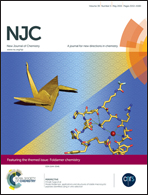A highly selective fluorescent sensor for Hg(ii) based on an NTe2 chelating motif and its application to living cell imaging†
Abstract
A fluorescent probe (NBDTe) based on an NTe2 chelating motif has been developed for the highly selective and sensitive detection of Hg2+. Significant fluorescence enhancement was observed with the chemosensor NBDTe in the presence of Hg2+. Moreover, the metal ions Ag+, Al3+, Ca2+, Cd2+, Co2+, Cu2+, Cr3+, Fe2+, Fe3+, Hg2+, Mg2+, Mn2+, Ni2+, Pb2+, and Zn2+ produced only minor changes in the fluorescence values of the system. The association constant (Ka) of Hg2+ binding to the chemosensor NBDTe was found to be 3.81 × 103 M−1, with a detection limit of 4.2 μM. The maximum fluorescence enhancement caused by Hg2+ binding to the chemosensor NBDTe was observed over the pH range of 4.0–10.0. In addition, fluorescence microscopy experiments showed that the chemosensor NBDTe can be used as a fluorescent probe for detecting Hg2+ in living cells.



 Please wait while we load your content...
Please wait while we load your content...